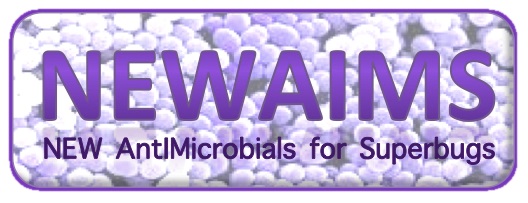NEWAIMS: New AntIMicrobials to starve Superbugs
Aree / Gruppi di ricerca
Partecipanti al progetto
- Spyrakis Francesca (Coordinatore/trice)
- Guglielmo Stefano (Ricercatore/trice)
- Lazzarato Loretta (Docente)
Descrizione del progetto

Members of other units:
Barbara Campanini (University of Parma, http://www.unipr.it/ugov/person/15104);
Luca Ronda (University of Parma, http://www.unipr.it/ugov/person/91268)
Matteo Levantino (University of Palermo, https://www.unipa.it/persone/docenti/l/matteo.levantino/)
Partners:
Sponsors:
Compagnia di San Paolo
Description:
Antimicrobial resistance represents one of the main current risks for human health. The development of bacteria resistant to the last resort antibiotics is responsible for more than 700,000 annual deaths and, if the trends continue, by 2050, 10 million people globally will die each year (The Review on Antimicrobial Resistance, 2014, UK). One of the most relevant multi-drug resistant superbug is Methicillin-resistant Staphylococcus aureus (MRSA). In Europe more than 10% of bloodstream S. aureus infections are caused by MRSA, with a resistance rate closer to 50%. To respond to this emerging threat, new treatments, new targets and alternative therapies are urgently needed to circumvent resistance.
The objective of the NEWAIMS project is to build a multidisciplinary platform for developing new antimicrobial candidates able to iron-starve superbugs and interfere with their growth in the human host, through an unexploited mechanism of action. Bacteria are cells in rapid growth and require iron for replication and invasion. MRSA and other superbugs express proteins, called hemophores, able to bind hemoglobin, extract the heme and transport it into the cytoplasm as a way to acquire iron. The relevance of iron acquisition for bacteria survival is witnessed by nutritional immunity raised by the host, such as the expression by vertebrates of siderocalin a protein able to bind enterobactin (a bacterial siderophore), thus preventing iron intake. Hemophores bind hemoglobin through their NEAr-iron transporter (NEAT) domain, as demonstrated by a structural study on the complex from S. aureus (Biochemistry 2014, 53:3922-3933). By mimicking the NEAT domain we plan to develop small molecules able to interfere with NEAT binding to human hemoglobin and prevent the occurrence of the first binding event fundamental for heme capture by the bacteria.
To reach this aim we will combine computational and synthetic chemistry with in vitro biochemical studies of protein-protein interaction. In silico analyses will guide the identification of small molecules and/or peptides mimicking the NEAT domain of S. aureus.
Advanced synthetic chemistry methodologies will be used to ameliorate the compounds properties and the inhibition activity. We aim to identify 5 potential antimicrobial candidates inhibiting the MRSA-hemoglobin interaction in the low micromolar range. The project will be carried on with the collaboration of Proff. L. Ronda and B. Campanini (Università di Parma), having a long-term experience in hemoglobin purification and biophysical characterization, in recombinant protein expression and purification and in the study of protein-protein and protein-ligand interactions.
Keywords: Staphylococcus aureus; Antimicrobial resistance; Superbugs
Links:




